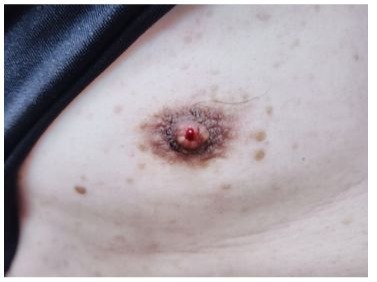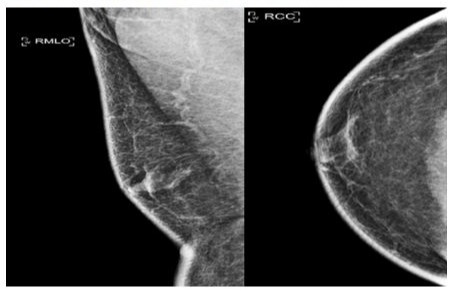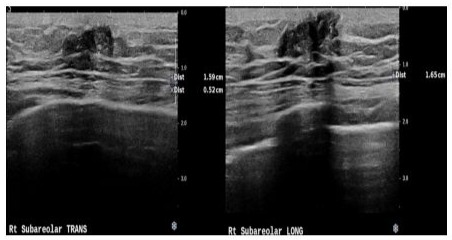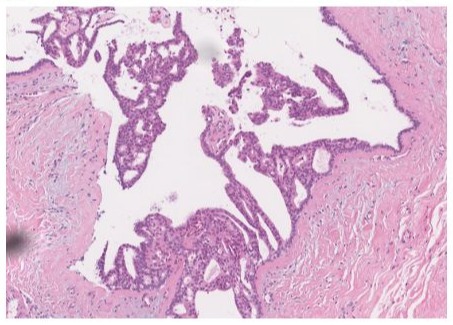Case Report of an Intraductal Papilloma of the Male Breast with a Typical Bloody Discharge
by By Ju Yeon Kim2, Eun Jung Jung1*, Jae Myung Kim2, Taejin Park1, Tae Han Kim1, JinKwon Lee1, Sang Ho Jeong1, Eun Cho3, Dae Hyun Song4, Han Shin Lee5
1Department of Surgery, Gyeongsang National University Changwon Hospital, Institute of Medical Science, Gyeongsang National University College of Medicine, Changwon, Korea
2Department of Surgery, Gyeongsang National University Hospital, Gyeongsang National University College of Medicine, Jinju, Korea
3Department of Radiology, Gyeongsang National University Changwon Hospital, Gyeongsang National University College of Medicine, Changwon, Korea
4Department of Pathology, Gyeongsang National University Changwon Hospital, Institute of Medical Science, Gyeongsang National University College of Medicine, Changwon, Korea 5Department of Surgery, UVA surgery Hospital, Pusan, Korea
5Department of Surgery, UVA surgery Hospital, Pusan, Korea
*Corresponding author: Eun Jung Jung, Department of Surgery, Gyeongsang National University Changwon Hospital, Gyeongsang National University College of Medicine, 11, Samjeongja-ro, Seongsan-Gu, Changwon 51472, Korea
Received Date: 8 December 2024
Accepted Date: 12 December 2024
Published Date: 16 December 2024
Citation: Kim BYJ, Jung EJ, Kim JM, Park T, Kim TH, et al. (2024) Case Report of an Intraductal Papilloma of the Male Breast with a Typical Bloody Discharge. Ann Case Report. 9: 2118. https://doi.org/10.29011/2574-7754.102118
Abstract
Intraductal papilloma is a rare benign breast disease characterized by the growth of epithelial cells within the mammary ducts. Although intraductal papilloma are more common in women than men, they are extremely rare in men. They often present with nipple discharge or nodules; therefore, differential diagnosis with breast cancer is important. This case report describes an intraductal papilloma presenting with bloody nipple discharge in a male patient who was diagnosed based on clinical presentation, imaging, and tissue biopsy and treated by excision. Although rare, this case highlights the importance of considering intraductal papilloma in the differential diagnosis of male breast masses and emphasizes the importance of imaging and biopsy in making an accurate diagnosis.
Keywords: Male breast, Intraductal papilloma, Gynecomastia, Bloody discharge
Introduction
Male breast tissues are composed of lactiferous ducts that are predominantly located in the subareolar region and lack terminal duct lobular units. Male breasts develop the same diseases as female breasts, although at a lower incidence. Although rare, breast cancer also occurs in men, accounting for 0.5-1% of all breast cancers [1]. Additionally, the male breast has the same benign lesions as the female breast, including fibro adenomas, fibrocystic changes, cysts, abscesses, and gynecomastia. Intraductal papilloma (IP) is a rare condition of the male breast, and several cases have been reported [2-4]. Herein, we report a rare case of papilloma presenting with bloody nipple discharge in a male breast with gynecomastia
Case Presentation
A 53-year-old man presented to our clinic with a 3-month history of bloody discharge from his right nipple. The patient was taking medications for diabetes and hypertension. Family history of breast cancer was negative. On physical examination, a firm, nodular mass was palpable under the nipple-areola area, and bloody discharge was noted in the right nipple (Figure 1).

Figure 1: Bloody discharge from the ducts in the male breast.
Breast imaging was then performed. On mammography, a focal asymmetric density was observed in the right subareolar area (Figure 2). Breast ultrasonography showed focal gynecomastia, and a hyper-vascular nodule with subareolar duct ectasia measuring 16 × 5 × 17 mm was observed in the right breast (Figure 3). The right subareolar nodule was determined to be at Category 4C risk and a biopsy was performed to differentiate breast cancer.

Figure 2: Mammography shows focal asymmetric density in the right subareolar region.

Figure 3: Breast ultrasound showing hyper-vascular nodule with subareolar duct ectasia measuring 16 × 5 × 17 mm in the right breast.

Figure 4: Intraductal papilloma of papillary structure with fibrovascular core are seen in the dilated subareolar duct. The epithelial cells show benign cytologic feature (x100, hematoxylin and eosin stain).
Discussion
Although rare, malignant and benign diseases occur in male breast. Male breast cancer is a rare disease, accounting for less than 1% of breast cancers [1]. The global incidence of breast cancer in both men and women has been increasing for decades [5]. Risk factors for male breast cancer include advanced age [6], hormone treatment for prostate cancer or estrogen-containing medications [6,7], family history of breast cancer [8,9], Klinefelter’s syndrome [10], chronic liver disease [11], and obesity [12].
In addition, Male breasts have the same benign lesions as female breasts, including fibroadenomas, fibrocystic changes, cysts, and abscesses, and gynecomastia. Intraductal papilloma is benign (noncancerous) disease that typically arise within breast duct. Although intraductal papilloma is more commonly diagnosed in women, they occur less frequently in men. Intraductal papilloma in men often present with specific clinical features and require proper diagnosis and management to rule out malignant conditions. In men, it can be asymptomatic or can cause specific symptoms [2-4]. The most common symptom is bloody or clear nipple discharge; however, some patients may also experience a palpable lump or pain. In some cases, the tumor may be small or no palpable. Although the exact cause of male intraductal papilloma is unclear, several risk factors have been reported to be associated with the likelihood of developing breast cancer. These include hormonal imbalances, advanced age, gynecomastia, and a family history of breast cancer or other breast-related conditions.
Ductal papilloma is usually benign and do not develop into cancer. Papilloma with atypical ductal hyperplasia has been reported [3]. These changes can lead to the development of cancer over time, including ductal carcinoma in situ. Gynecomastia is a condition characterized by the enlargement of breast tissue in men and has been reported to be associated with intraductal papilloma [4,13]. The intraductal papilloma in our patient also presented with bloody nipple discharge and mild gynecomastia.
Diagnosis is usually made through a combination of physical examination, imaging tests, and tissue biopsy. Mammography and ultrasonography can help determine ductal abnormalities or mass in the breast; however, a biopsy is needed for a definitive diagnosis.
Intraductal papilloma in men is usually treated in the same way as in women. Intraductal papilloma are usually treated with surgical excision to remove the papilloma. Early diagnosis and treatment with surgical excision usually result in good outcome. Intraductal papilloma is benign and rarely associated with breast cancer, but it is important to recognize that they can occur in men to rule out malignancy and treat them appropriately.
Conflict of Interest
No authors have any conflict of interest.
Informed consent
We have obtained consent from the patient to publish the case.
References
- Speirs V, Shaaban AM. (2009). The rising incidence of male breast cancer. Breast cancer research and treatment. 115: 429-430.
- Tsilimigras DI, Ntanasis-Stathopoulos I, Bakopoulos A, Schizas D, Kalfa M, et al. (2017). Intraductal papilloma of the breast in an 11-yearold male patient: a case report. Pediatric surgery international, 33: 727-730.
- Bharti S, Bharti JN, Vishnoi JR, Soudamini AB. (2020). A rare case of intraductal papilloma with atypical ductal hyperplasia in a male breast: A pathological diagnosis. Journal of family & community medicine. 27: 216-218.
- Vagios I, Nonni A, Liakea A, Constantinidou A, Kontos M. (2019). Intraductal papilloma of the male breast: a case report and review of the literature. Journal of surgical case reports. 2019: rjz023.
- Bray F, Ferlay J, Soerjomataram I, Siegel RL, Torre LA, et al. (2018). Global cancer statistics 2018: GLOBOCAN estimates of incidence and mortality worldwide for 36 cancers in 185 countries. CA: a cancer journal for clinicians. 68: 394-424.
- Benassai G, Miletti A, Calemma F, Furino E, De Palma GD, et al. (2020). Male breast cancer: an update. Annali italiani di chirurgia. 91: 359-365.
- Konduri S, Singh M, Bobustuc G, Rovin R, Kassam A. (2020). Epidemiology of male breast cancer. Breast. 54: 8-14.
- Rosenblatt KA, Thomas DB, McTiernan A, Austin MA, Stalsberg H, et al. (1991). Breast cancer in men: aspects of familial aggregation. Journal of the National Cancer Institute. 83: 849-854.
- Silvestri V, Barrowdale D, Mulligan AM, Neuhausen SL, Fox S, et al. (2016). Male breast cancer in BRCA1 and BRCA2 mutation carriers: pathology data from the Consortium of Investigators of Modifiers of BRCA1/2. Breast cancer research: BCR, 18: 15.
- Hultborn R, Hanson C, Köpf I, Verbiené I, Warnhammar E, et al. (1997). Prevalence of Klinefelter’s syndrome in male breast cancer patients. Anticancer research, 17: 4293-4297.
- Sørensen HT, Friis S, Olsen JH, Thulstrup AM, Mellemkjaer L, et al. (1998). Risk of breast cancer in men with liver cirrhosis. The American journal of gastroenterology. 93: 231-233.
- Lees T, Cullinane A, Condon A, Shabaan AM, Humphries MP, et al. (2018). Characterising the adipose-inflammatory microenvironment in male breast cancer. Endocrine-related cancer. 25: 773-781.
- Kapila K, Verma K. (2003). Cytology of nipple discharge in florid gynecomastia. Acta cytological. 47: 36-40.
© by the Authors & Gavin Publishers. This is an Open Access Journal Article Published Under Attribution-Share Alike CC BY-SA: Creative Commons Attribution-Share Alike 4.0 International License. Read More About Open Access Policy.